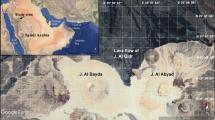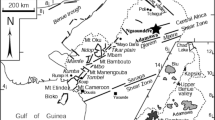Summary
The Palampur metavolcanics (PV) in the northwest Himalaya are part of the Late Archaean (2.5 Ga) Rampur flood basalt province (RFBP) which represents one of the oldest manifestation of worldwide mafic magmatism. The volcanics occur as mafic lava flows with evidence of two phases of deformation. The first phase resulted in recrystallisation which almost completely obliterated the primary mineralogy, and the second phase was of weak cataclasis. Immobile trace element ratios as well as cation percent Al - (Fe - Ti) - Mg indicate that the volcanics are tholeiitic in composition. The chemical characteristics, such as the decoupling between HFS and LIL elements i.e., distinct negative Sr, Nb and Ti anomalies in the double normalisation ratios spiderdiagram together with low Ti/Y and Zr/Y ratios, testify the rocks as low-Ti continental flood basalts. The chemical variations in the volcanics can be related to varying extents of partial melting of the mantle source(s), followed by fractional crystallisation (predominantly olivine and clinopyroxene over plagioclase). Positive correlation between LREE and Fe abundances, Ce-Nd and Y/Nd-Zr/Y data preclude any significant role of crustal contamination in the evolution of their bulk chemistry. The REE data and [Mg]-[Fe] relations rather suggest that the parental magma of the PV derived from non-pyrolitic source(s) which was heterogeneous with respect to enrichment in Zr, LREE and Fe/Mg ratios. Mantle metasomatism appears to be the main process of such source enrichment, possibly caused by the addition of a volatilerich silicate melt phase.[/ p]
Zusammenfassung
Die Palampur Metavulkanite (PV), im nordwestlichen Himalaya, gehören zur spätarchaiischen (2.5 Ga) Rampur Plateau-Basalt-Provinz (RFBP), die einen der ältesten, weltweiten Phasen von mafischem Magmatismus manifestiert. Die Vulkanite treten als mafische Lavaströme auf und zeigen zwei Phasen von Deformation. Die erste resultierte in einer Rekristallisation, die nahezu den gesamten primären Mineralbestand überprägt hat. Die zweite Phase ist durch schwache Kataklase repräsentiert. Immobile Spurenelementverhältnisse, wie auch die Kationenprozent von Al- (Fe- (-Ti) -Mg, deuten eine tholeiitische Zusammensetzung der Vulkanite an. Die chemischen Charakteristika, die im unterschiedlichen Verhalten der HFS und LIL Elemente deutlich werden, deutlich negative Sr, Nb und Ti Anomalien in den zweifach normalisierten Spiderdiagrammen, niedrige Ti/Y und Zr/Y Verhältnisse, bezeugen, dass es sich um Ti-arme, kontinentale Plateaubasalte handelt. Die chemischen Unterschiede innerhalb der Vulkanite können auf unterschiedliche Grade von Aufschmelzung des (der) Mantelmaterials(e), gefolgt von fraktionierter Kristallisation (vor allem Olivin und Klinopyroxen, untergeordnet Plagioklas), zurückgeführt werden. Positive Korrelation der LREE mit Fe, wie auch die Ce-Nd und Y/Nd-Zr/Y Daten schließen eine signifikante Rolle von Krustenkontamination in der Evolution der Gesteinschemie aus. Die REE Daten und die /Mg/-/Fe/ Verhältnisse lassen eher vermuten, dass das Ausgangsmagma der PV von einem nicht-pyrolitischen Material stammt, welches bezüglich Anreicherung an Zr, LREE und Fe/Mg Verhältnis heterogen gewesen ist. Mantelmetasomatose scheint der Hauptprozeß für diese Anreicherng des Ausgangsmaterials gewesen zu sein, die möglicherweise durch Zufuhr einer silikatischen Schmelzphase, reich an flüchtigen Bestandteilen, hervorgerufen wurde.[/ p]
Similar content being viewed by others

References
Abu-Hamatteh ZSH, Raza M, Ahmad T (1994) Geochemistry of early Proterozoic mafic and ultramafic rocks of Jharol Group, Rajasthan, northwestern India. J Geol Soc India 44: 141–156
Ahmad T, Bhat MI (1987) Geochemistry and petrogenesis of the Mandi-Darla volcanics, northwestern Himalayas. Precamb Res 37: 231–256
Ahmad T, Rajamani V (1991) Geochemistry and petrogenesis of the basal Aravalli volcanics near Nathdwara, Rajasthan, India. Precamb Res 49: 185–204
Ahmad T, Tarney J (1991) Geochemistry and petrogenesis of Garhwal volcanics: implications for evolution of the north Indian lithosphere. Precamb Res 50: 69–88
Ahmad T, Tarney J (1993) North Indian Proterozoic volcanics, products of lithosphere extension: geochemical studies bearing on lithosphere derivation. In:Casshyap SM et al. (eds) Rifted basin and aulacogens. Gyanodaya Prakashan, Nainital, pp 130–146
Ahmad T, Tarney J (1994) Geochemistry and petrogenesis of late Archaean Aravalli volcanics, basement enclaves and granitoids, Rajasthan. Precamb Res 65: 1–23
Allégre CJ, Minster JF (1978) Quantitative models of trace element behaviour in magmatic processes. Earth Planet Sci Lett 38: 1–25
Anderson DL (1990) Theory of the earth. Blackwell Scientific Publications, 384 pp
Bhat MI (1987) Spasmodic rift reactivation and its role in the pre-orogenic evolution of the Himalayan region. Tectonophysics 134: 103–127
Bhat MI, Le Fort P (1992) Sm-Nd age and petrogenesis of Rampur metavolcanic rocks, NW Himalayas: Late Archaean relics in the Himalayan belt. Precamb Res 56: 191–210
Bhat MI, Le Fort P (1993) Nd-isotope study of the Late Archaean continental tholeiites, NW Himalaya: a case of ocean island basalt source for continental tholeiites. J Him Geol 4: 1–13
Bhat MI, Claesson S (dy1995) Nd-isotopic evidence for the Middle Proterozoic age of the Bafliaz volcanics, NW Himalayas and the mantle origin of their crustal signature. Abstr, Second South Asia Geol Congr, Colombo, p 29
Bhat MI, Claesson S, Dubey AK, Pandey K (1994a) Late Archaean Rampur low-Ti flood basalt province of the Himalaya: vestiges of one of the oldest recorded flood basalt eruptions. Abstr, Group Meeting on Seiesmotectonics and Geodynamics of the Himalaya, p 4.
Bhat MI, Le Fort P, Ahmad T (1994b) Bafliaz volcanics, NW Himalaya: origin of a bimodal, tholeiite and alkali basalt suite. Chem Geol 114: 217–234
Bodinier JL, Vasseur G, Vernieres J, Dupuy C, Fabries J (1990) Mechanisms of mantle metasomatism: geochemical evidence from the Lherz orogenic peridotite. J Petrol 31: 587–628
Brown GC, Hughes DJ, Esson J (1972) New XRF data retrieval techniques and their application to USGS standard rocks. Chem Geol 11: 223–229
Budahn JR, Schmitt RA (1985) Petrogenetic modelling of Hawaiin tholeiitic basalts: a geochemical approach. Geochim Cosmochim Acta 49: 67–87
Condie KC (1982) Archaean andesites. InThorpe RS (ed) Andesites: orogenic and related rocks. Wiley, New York, pp 575–590
Dupuy C, Dostal J (1984) Trace element geochemistry of some continental tholeiites. Earth Planet Sci Lett 67: 61–69
Floyd PA, Winchester JA (1975) Magma type and tectonic setting discrimination using immobile elements. Earth Plant Sci Lett 27: 211–218
Franics D, Ludden J, Hynes A (1983) Magma evolution in a Proterozoic rifting environment. J Petrol 24: 556–582
Hanson GN (1978) The application of trace elements to the petrogenesis of igneous rocks of granitic composition. Earth Planet Sci Lett 38: 26–43
Hanson GN (1980) Rare earth elements in petrogenetic studies of igneous rocks. Ann Rev Earth Planet Sci 8: 371–406
Hanson GN, Langmuir CH (1978) Modeling of major elements in mantle-melt systems using trace element approaches. Geochim Cosmochim Acta 42: 725–741
Hellman PL, Henderson P (1977) Are rare earth elements mobile during spilitisation? Nature 267: 38–40
Hellman PL, Smith RE, Henderson P (1976) The mobility of the rare earth elements: evidence and implications from selected terrains affected by burial matamorphism. Contrib Mineral Petrol 71: 23–44
Herget JM, Peat DW, Hawkesworth CJ (1991) The petrogenesis of Mesozoic Gondwana low-Ti flood basalts. Earth Planet Sci Lett 105: 134–148
Holm PE (1985) The geochemical fingerprints of different tectonomagmatic environments using hygromagmatophile element abundances of tholeiitic basalts and basaltic andesites. Chem Geol 51: 303–323
Horan MF, Hanson GN, Spencer KJ (1987) Pb and Nd isotope and trace element constraints on the origin of basic rocks in an early Proterozoic igneous complex, Minnesota. Precamb Res 37: 323–342
Jensen LS (1976) A new cation plot for classifying subalkaline volcanic rocks. Ontario Dep Mines Misc Pap 66: 22 pp
Kersting AB, Arculus RJ (1994) Klyuchevskoy volcano, Kamchatka, Russia: the role of high-flux recharged, tapped, and fractionated magma chamber(s) in the genesis of high Al2O3 from high-MgO basalt. J Petrol 35: 1–41
Klein EM, Langmuir CH (1987) Global correlations of ocean ridge basalt chemistry with axial depth and crustal thickness. J Geophys Res 92: 8089–8115
Langmuir CH, Hanson GN (1980) An evaluation of major element heterogeneity in the mantle sources of basalts. Phil Trans R Soc London 297: 383–407
Menzies MA, Roggers N, Tindle A, Hawkesworth CJ (1987) Metasomatic and enrichment processes in lithospheric peridotites: an effect of asthenosphere-lithosphere interaction. In:Menzies MA, Hawkesworth CJ (eds) Mantle matasomatism. Academic Press, London, pp 313–361
Myers RE, Breitkopf JH (1989) Basalt geochemistry and tectonic settings: a new approach to relate tectonic and magmatic processes. Lithos 23: 53–62
Nicholson H, Latin D (1992) Olivine tholeiites from Krafla, Iceland: evidence for variations in melt fraction within a plume. J Petrol 33: 1105–1124
Pareek HS (1973) Geological setting, petrography and petrochemistry of Darla traps, and its comparative study with Mandi and Panjal traps. J Geol Soc India 14: 355–368
Patwardhan AM, Bhandari A (1974) Petrogenesis of spilites occurring at Mandi, Himachal Pradesh, India. In:Amstutz GC (ed) Spilites and spilitic rocks. Springer, Berlin Heidelberg New York, pp 175–189
Pearce JA (1984) A “user's guide” to basalt discrimination diagrams. In:Tarney J (ed) Oceanic basalts. Shiva Publications, Amsterdam, pp 230–240
Rajamani V, Shivkumar K, Shirey SB, Hanson GN (1985) Geochemistry and petrogenesis of amphibolites, Kolar Schist Belt, South India: evidence for komatiitic magma derived by low percentages of melting of the mantle. J Petrol 26: 92–123
Rajamani V, Shirey SB, Hanson GN (1989) Fe-rich tholeiites derived from melt-enriched mantle sources: evidence from the Kolar Schist Belt, South India. J Geol 97: 487–501
Rajamani V, Balakrishnan S, Hanson GN (1993) Application of Mg-Fe diagram to genesis of komatiitic rocks. J Geol 101: 809–819
Smith RE, Smith SE (1976) Comments on the use of Ti, Zr, Y, Sr, K, P and Nb in classification of basaltic magmas. Earth Plant Sci Lett 32: 114–120
Srikantia SV (1977) The Sundernagar Group: its geology, correlation and significance as stratigraphically the deepest sediment in the Peninsular or Lesser Himalaya. J Geol Soc India 18: 7–22
Srikantia SV, Sharma RP (1976) Geology of the Shali belt and the adjoining area. Mem Geol Surv India 106: 31–166
Sun S-S, Hanson GN (1975) Evolution of the mantle: geochemical evidence from alkali basalts. Geology 3: 297–302
Sun S-S, McDonough WF (dy1989) Chemical and isotopic systematics of ocean basalt: implications for mantle composition and processes. In:Saunders AD, Norry MJ (ededs) Magmatism in ocean basins. Geol Soc London Spec Publ 42: 313–345
Weaver BL, Tarney J (1983) The chemistry of the sub-continental mantle: inference from Archaean and Proterozoic dykes and continental flood basalts. In:Hawkesworth CI, Norry MJ (eds) Continental basalts and mantle xenoliths. Shiva Publ, Nantwich, pp 209–229
Zuleger E, Erzinger J (1988) Determination of the REE and Y in silicate materials with ICP-AES. Fresenius Z Anal Chem 332: 140–143
Author information
Authors and Affiliations
Rights and permissions
About this article
Cite this article
Chaudhri, N., Joseph, B. Geochemistry and petrogenesis of the Palampur metavolcanics, Lesser Himachal Himalaya, India. Mineralogy and Petrology 59, 189–205 (1997). https://doi.org/10.1007/BF01161859
Received:
Accepted:
Issue Date:
DOI: https://doi.org/10.1007/BF01161859



